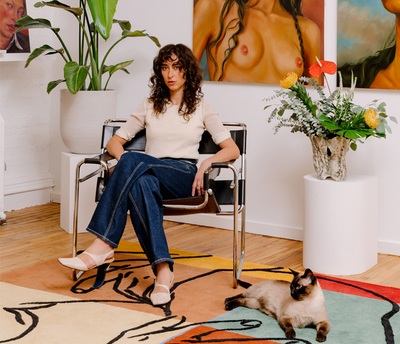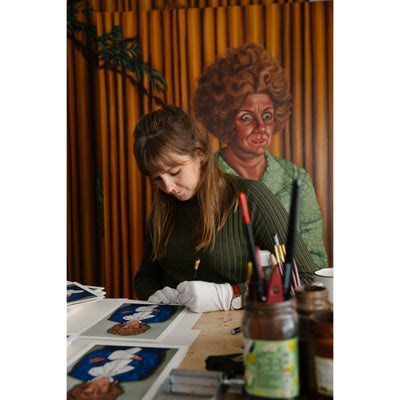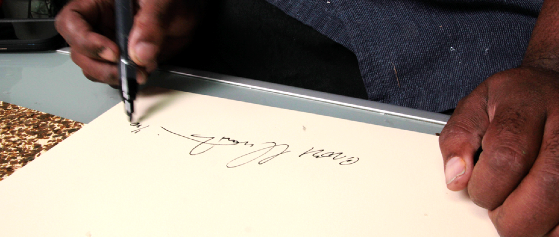
DECODING RYAN MCGINNESS
In celebration of our fourth collaborative edition, the artist shares unique insight into the symbolic mapping he used to create its compositional elements.
Reflecting the image saturation present in contemporary life, McGinness' distinctive visual language blends organic natural with synthetic commercial, resulting in familiar yet complex compositions that navigate like personal memories translated by an alien tongue.
Here, McGinness provides detailed examples of his coded imagery, breaking down the breadth of influence on view in his new edition, Operation Mindfuck (2023), available to collect now.
![]()
XA: I'm really interested in your image selection process. How did you narrow down which references to employ in these editions?
Ryan McGinness: The references are purposefully random. The drawings are pulled together based primarily on aesthetic and composition criteria. Meaning emergence is how we each construct our worldviews and, by extension, our universe. My works are worlds unto themselves.
![]()
The title of our forthcoming release is derived from the satirical conspiracy theory started by Robert Anton Wilson and Kerry Thornley, co-founder of the parody religion called Discordianism.
 Discordianism emerged from the psychedelic 60s, inspired by the ideas of Ayn Rand and catalyzed by the growing paranoia of the Nixon era, eventually birthing Operation Mindfuck, an organized attempt to spread the now-infamous Illuminati conspiracy theory.
Discordianism emerged from the psychedelic 60s, inspired by the ideas of Ayn Rand and catalyzed by the growing paranoia of the Nixon era, eventually birthing Operation Mindfuck, an organized attempt to spread the now-infamous Illuminati conspiracy theory.
Symbolically, this is referenced in the upper left hand quadrant: an eye housed within an upside down triangle, balancing on a pyramid-like structure, crowned with a flowering skull atop a two-headed turtle.

“Conspiracies are belief-based black holes any intellectually stimulated individual can fall into. The cul-de-sac thinking can lead one to simultaneously believe that I am not a part of the conspiracy while making such a claim confirms that I am. Where the mind folds in on itself is where I want to be.”
— Ryan McGinness, 2023

XA: I imagine you keeping a sophisticated organizational system to chronicle your collections of symbols — but is it actually a more organic process where you riff in the moment? Or some combination of both? Are there favorite symbols of yours that end up getting repeated across works? What about ones that never make the cut?
RM: I do have periodic tables that are organized by subject. I am constantly adding to these tables. When bringing the elements together, I do rely on my intuition and sense of composition (which we can characterize as being organic). But on the other hand, even when composing, my process is rather uptight, and I have my own set of rules. (For example, typically, elements remain square to the picture plane.) And, yes, some drawings remain in the mix for years while others fall by the wayside. Some symbols that have become more signature reflect sentiments that apply to all the work and are core expressions of who I am and what I make. For example, the radiating eyes are a psychedelic vision that remind us of that aspect of the work. And the ouroboros tends to show up a lot, because it is about how all my work folds in on itself.
The jovial central figure balancing atop a candle pays homage to Cornelis Dusart's Februari (c. 1679 - 1704), in which a jester-type entertainer holding bric-a-brac dances impishly amongst two children.


In the lower right hand corner, a deconstructed individual stands at a slant, encased within a bold circular outline. Recalling the simplified bodily forms featured universally on crosswalks, there is the symbol itself, sitting on the surface, and there is the tapestry of coded meaning that lies beneath.

Its original form echoes Hieronymus Bosch's The Pedlar (c. 1500). The Pedlar represents humanity's forge through life, weighed by the baggage of ever-present temptation.

McGinness isolated the pedlar's mid-step contrapposto, highlighting angles where the form could be deconstructed while retaining its essential movement.

"The work I make is a reflection of how the mind works, which is a lot like computer RAM (Random Access Memory). All memories are available all the time, and we make sense (or nonsense) of them through a desperate ordering. This most often takes place when we dream. Each individual drawing (or unit of meaning) is carefully constructed and contains a discrete meaning. However, expressed together in a composition, meaning is constructed through juxtapositions, spacial associations, and proximity. My goal is not to present a concrete and static narrative. I am more interested in that gap between intention and interpretation."
— Ryan McGinness, 2023

Operation Mindfuck's earthen palette — rich brown grounding pastel blue — evokes a sense of early time, cool water rushing through sediment.
McGinness emphasized this effect through the compositional structure, which reads as if a cascading waterfall was set to sea in a world unmoored by gravity.

Shepherds of this effect nestle directly above the central plane; Mirrored figures pour identical vessels towards a suspended ovoid housing clown-like elements.
Simultaneously referencing Gerrit Dou's Maid at the Window (c. 1650) and Gino Severini's Pierrot with Guitar (c. 1923), McGinness continues to draw on his expansive art-historical knowledge while rendering it wholly anew.




As we continue to mine the picture plane, we notice time is cycling non-linearly. Increasingly surreal symbols sprinkle throughout the work, speaking to psychedelics and the undermining of a shared reality, including citations to Dadaism, the early 20th century anti-art movement; Comedian (2019), the conceptual anti-art artwork, by Maurizio Cattelan; Bull's Head (1942) by Pablo Picasso; and Jean Arp's Arpaden drawings.






XA: I love that Operation Mindfuck is part of a suite of editions we've had the pleasure of collaborating on [Previous editions include Sitting in the Basement Knitting (2021), Order of Operations (2021), and The Sin of Pride (2022).] What role do you see these editions playing in your larger practice?
RM: Aesthetically and materially, this series is a subset of work I have been making for over 20 years. I love porcelain-baked enamel on steel, so any chance I can use it, I will. I love making editioned work as a counterpoint to the more expensive unique works.




 Inside the Studio
Inside the Studio





